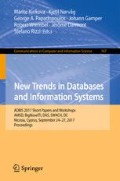Abstract
Outlier detection is an important tool for many application areas. Often, data has some multidimensional structure so that it can be viewed as OLAP cubes. Exploiting this structure systematically helps to find outliers otherwise undetectable. In this paper, we propose an approach that treats streaming data as a series of OLAP cubes. We then use an offline calculated model of the cube’s expected behavior to find outliers in the data stream. Furthermore, we aggregate multiple outliers found concurrently at different cells of the cube to some user-defined level in the cube. We apply our method to network data to find attacks in the data stream to show its usefulness.
This work has partly been developed in the project IQM4HD (reference number: 01IS15053B). IQM4HD is partly funded by the German ministry of education and research (BMBF) within the research program KMU Innovativ.
Access this chapter
Tax calculation will be finalised at checkout
Purchases are for personal use only
Notes
- 1.
- 2.
A mobile network cell, not a cube cell.
References
Aggarwal, C.C.: Outlier Analysis, 1st edn. Springer, New York (2013). doi:10.1007/978-1-4614-6396-2
Chandola, V., Banerjee, A., Kumar, V.: Anomaly detection: a survey. ACM Comput. Surv. 41(3), 15:1–15:58 (2009). http://doi.acm.org/10.1145/1541880.1541882
Dunstan, N., Despi, I., Watson, C.: Anomalies in multidimensional contexts. WIT Transa. Inform. Commun. Technol. 42, 173 (2009). http://www.witpress.com/elibrary/wit-transactions-on-information-and-communication-technologies/42/19978
Han, J., Chen, Y., Dong, G., Pei, J., Wah, B.W., Wang, J., Cai, Y.D.: Stream cube: an architecture for multi-dimensional analysis of data streams. Distrib. Parallel Databases 18(2), 173–197 (2005). http://link.springer.com/article/10.1007/s10619-005-3296-1
Li, X., Han, J.: Mining approximate top-k subspace anomalies in multi-dimensional time-series data. In: Proceedings of the 33rd International Conference on Very Large Data Bases, pp. 447–458. VLDB Endowment (2007)
Lin, S., Brown, D.E.: Outlier-based Data Association: Combining OLAP and Data Mining. Department of Systems and Information Engineering University of Virginia, Charlottesville, VA 22904 (2002). http://web.sys.virginia.edu/files/tech_papers/2002/sie-020011.pdf
Lippmann, R., Fried, D., Graf, I., Haines, J., Kendall, K., McClung, D., Weber, D., Webster, S., Wyschogrod, D., Cunningham, R., Zissman, M.: Evaluating intrusion detection systems: the 1998 DARPA off-line intrusion detection evaluation. In: DARPA Information Survivability Conference and Exposition, DISCEX 2000, Proceedings, vol. 2, pp. 12–26 (2000)
Müller, E., Assent, I., Iglesias, P., Mülle, Y., Böhm, K.: Outlier ranking via subspace analysis in multiple views of the data. In: 2012 IEEE 12th International Conference on Data Mining, pp. 529–538. IEEE (2012). http://ieeexplore.ieee.org/xpls/abs_all.jsp?arnumber=6413873
Palpanas, T., Koudas, N., Mendelzon, A.: Using datacube aggregates for approximate querying and deviation detection. IEEE Trans. Knowl. Data Eng. 17(11), 1465–1477 (2005)
Rettig, L., Khayati, M., Cudré-Mauroux, P., Piórkowski, M.: Online anomaly detection over Big Data streams. In: 2015 IEEE International Conference on Big Data (Big Data), pp. 1113–1122 (2015)
Sarawagi, S., Agrawal, R., Megiddo, N.: Discovery-driven exploration of OLAP data cubes. In: Schek, H.-J., Alonso, G., Saltor, F., Ramos, I. (eds.) EDBT 1998. LNCS, vol. 1377, pp. 168–182. Springer, Heidelberg (1998). doi:10.1007/BFb0100984
Sithirasenan, E., Muthukkumarasamy, V.: Substantiating anomalies in wireless networks using group outlier scores. J. Softw. 6(4), 678–689 (2011)
Thatte, G., Mitra, U., Heidemann, J.: Parametric methods for anomaly detection in aggregate traffic. IEEE/ACM Trans. Networking 19(2), 512–525 (2011)
Xin, D., Han, J., Li, X., Wah, B.W.: Star-cubing: Computing iceberg cubes by top-down and bottom-up integration. In: Proceedings of the 29th International Conference on Very Large Data Bases, vol. 29, pp. 476–487. VLDB Endowment (2003)
Author information
Authors and Affiliations
Corresponding author
Editor information
Editors and Affiliations
Rights and permissions
Copyright information
© 2017 Springer International Publishing AG
About this paper
Cite this paper
Heine, F. (2017). Outlier Detection in Data Streams Using OLAP Cubes. In: Kirikova, M., et al. New Trends in Databases and Information Systems. ADBIS 2017. Communications in Computer and Information Science, vol 767. Springer, Cham. https://doi.org/10.1007/978-3-319-67162-8_4
Download citation
DOI: https://doi.org/10.1007/978-3-319-67162-8_4
Published:
Publisher Name: Springer, Cham
Print ISBN: 978-3-319-67161-1
Online ISBN: 978-3-319-67162-8
eBook Packages: Computer ScienceComputer Science (R0)

